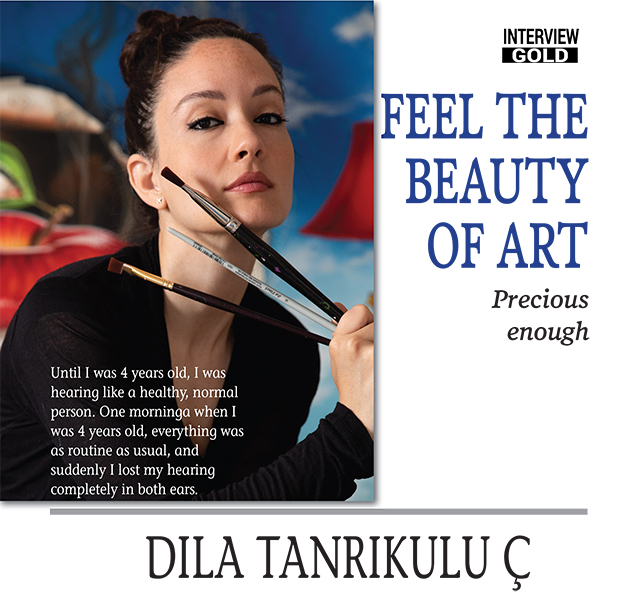Dila Tanrıkulu Ç
Share this Post:

Dila Tanrıkulu Ç. has been producing internationally recognized works in the field of painting since1999. The artist has been pursuing her ideals as a hearing-impaired person since a very young age.
She prefers to paint mainly portraits and figurative works in oil and acrylic, as well as surrealistic stylepaintings. While trying to hear a little with the help of a hearing aid, she also communicates by reading lips. When we look at the artist’s works, this special condition of the artist is reflected in the elaborative aspect of her existing imagination.
After completing her graduate degree at Mimar Sinan University, Faculty of Fine Arts, Department of Painting in İstanbul, she established her own studio in Sweden and she still continues her works there.
When we look at your works as a viewer, it seems that you have an extraordinary character with your different style preferences. Could you tell us about your work and the main ideas you want to express?
As it seems, in terms of style, in addition to my expressionist figurative artworks, I prefer to paint predominantly in the surrealist style. Through this style, I feel I am myself and spiritually complete. With this style of painting, I aim to drag the viewer into a deep existential feeling and a state of questioning in a philosophical context. My surrealistic paintings, emphasizing the symbolic images with deep meanings that I often use, consist of the fiction of philosophical subjects that exist in the subconscious of almost every person and have questioned themselves at least once and its surroundings. To summarize, these visual fictions of mine can sometimes manifest themselves with a cry in my existing silent world, with the rebellion that occurs as a result of the inevitable questioning of life, and from time to time they can leave their place to the peace of a spiritual and mystical surrender. Therefore, I can say that all my surreal works are the product of a general human emotion and a state of questioning that is inevitable and variable over time.
My paintings in other genres are also occasionally created by my need to look at life from different perspectives, to experience different flavors and to be inspired by them.
We see that you often use the apple in your paintings. Is this a dominant symbolic depiction that you particularly want to emphasize?
Yes, the depiction of the apple is one of the most emphasizing symbols in my paintings. The myth of the apple, as an image that is constantly used in myths, sacred books, fairy tales, idioms and folk songs, has a feature that still exists from the past to the present. At first glance, the apple symbolizes the first sin, worldly wants and desires, weaknesses, and the first lesson for humanity. Although it has different meanings in various cultures, these are its general connotations. Apart from this, from time to time, I try to express the totality of negative actions and events with this symbol by abstracting the apple depiction from religion but still evoking it. I usually create the fiction of my surrealistic paintings around the apple depiction.
Is your hearing impairment a congenital condition? Can you tell us about the development of events related to the subject?
Until I was 4 years old, I was hearing like a healthy, normal person. One morning when I was 4 years old, everything was as routine as usual, and suddenly I lost my hearing completely in both ears. The cause of this loss is unknown, because there is no technology yet that can detect and show the damage site of my problem. One year after the loss, I completely forgot how to speak. I started lip- reading training for a while to relearn how to speak and communicate again. Until I was 12 years old, I only communicated with people by reading lips. I was looking very carefully at the lips of the people speaking in front of me in order to understand them and I could manage with my reddened eyes, even though it was very tiring at the time. Sometimes I pretended to understand because I was tired or because I didn’t want to make the other person repeat themselves, so as not to overwhelm them too much. If I had learned sign language first, I would not have been able to develop myself so quickly and I would have wanted to surround myself with a group of people who could only use sign language for communication and perhaps I would have limited myself to this circle. In this respect, it was a big plus in my life that I first received lip-reading training. I don’t know sign language yet, but I plan to improve myself in that area in the future in order to be useful to society and myself. When I was 12 years old, I underwent Cochlear Implant surgery so that I could use a special ear device and I still use this special device. After I started using this device, my communication with people became a little easier. To give an example of exactly how I hear sounds with my ear device; I hear it as if the printer has run out of ink and it just looks like a badly printed text. Therefore, when there are parts that I do not understand aurally, I complete it by lip-reading. I hope this example was explanatory. When I am not using my device, I am like a wall. However, throughout my life, I have never rebelled against this and have always focused on improving myself. This has been like the beginning of a story to enrich me. I feel very grateful to have parents who have always supported me financially and emotionally in these matters. I especially owe my mother big-time, who has contributed greatly to my development with sacrifices.
Is it possible to see any effect of your hearing impairment on your painting and artistic development?
This may have partly influenced the detail-oriented style of my paintings. Because when the ears were dysfunctional except for wearing earrings, my eyes compensated for the missing function of hearing. For this reason, since it caused me to examine my surroundings in more detail, I may inevitably reflect this in my paintings with my detail-oriented style. In short, this situation may have partially strengthened my visual memory.
Please name 2 artists who inspired your work?
Salvador Dali. In his works, I see a magnificent product of innovative intelligence that he expresses the mental and spiritual complexity of the human being so clearly by using symbolic images on a single surface without the need for verbal communication by appealing to visual aesthetics as well.
Anotherone is William-Adolphe Bouguereau was a French painter of the 18th century.
READ THIS INTERVIEW ON THE MAGAZINE PAGE
DILA TANRIKULU C IS A WINNER OF EDITOR'S CHOICE AWARD OF EXCELLENCE
Get Dila Tanrikulu C. featured on the Reader's House magazine both print and electronic. The magazine is available over 190 countries and around 40.000 platforms, wholesalers, retailers and libririres including Amazon, Barnes & Noble, Waterstones... Here are some of the stores you can get the magazine in print and electronic;

US UK DE FR ES IT NL JP BR CA MX AU IN
USA CA UK IN AU HK JP PH SG TW TH AT BE CY EE FI GR IE IT TR
and more at UK STORES - USA STORES and GLOBAL
Click the button below to see interview magazine layout.
